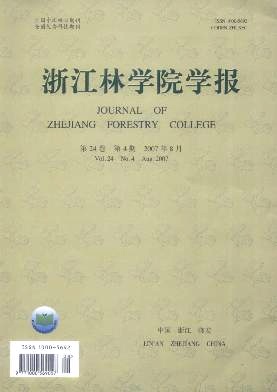| [1] |
ZENG Hong, CHEN Conglin, YU Jing, XIANG Lin, SUN Yimiao, HU Mingyue, HAO Jianfeng.
Effects of human interference on species diversity and biomass of Eucalyptus grandis plantation in Cangping Mountain Park in Ya’an
. Journal of Zhejiang A&F University,
2021, 38(2): 253-261.
doi: 10.11833/j.issn.20950756.20200312
|
| [2] |
YE Sentu, JIN Chao, WU Chuping, YANG Tangliang, JIANG Bo, YUAN Weigao, HUANG Yujie, JIAO Jiejie, SUN Jiejie.
Classification, ordination and correlation analysis of dominant species of ecological non-commercial forests in Songyang, Zhejiang
. Journal of Zhejiang A&F University,
2020, 37(4): 693-701.
doi: 10.11833/j.issn.2095-0756.20190514
|
| [3] |
ZHANG Rong, LI Tingting, JIN Suo, YU Shunyao, WANG Yu, LI Yujiang, QI Jinqiu, HAO Jianfeng.
Effects of human disturbance on species diversity and soil physiochemical properties of Schima superba community in Mengding Mountain
. Journal of Zhejiang A&F University,
2020, 37(5): 867-875.
doi: 10.11833/j.issn.2095-0756.20190554
|
| [4] |
JIN Mengli, HU Jun, QI Shi, LU Jinsheng, LI Yue, JIANG Jiuhua.
Reconstruction measures of species diversity of low-function Platycladus orientalis forest in Beijing
. Journal of Zhejiang A&F University,
2020, 37(1): 27-35.
doi: 10.11833/j.issn.2095-0756.2020.01.004
|
| [5] |
WU Shibin, KU Weipeng, ZHOU Xiaorong, JI Meifen, WU Jiasen.
Structural characteristics and species diversity for survival of the rare plant Ostrya multinervis
. Journal of Zhejiang A&F University,
2019, 36(1): 31-37.
doi: 10.11833/j.issn.2095-0756.2019.01.005
|
| [6] |
DENG Hongjian, LI Weizhong, CAO Zhu, WANG Qing, WANG Guangru.
Species diversity based on sample size in a Pinus tabulaeformis mixed forest
. Journal of Zhejiang A&F University,
2015, 32(1): 67-75.
doi: 10.11833/j.issn.2095-0756.2015.01.010
|
| [7] |
QIAN Yifan, HAN Bingyuan, Yilita, ZHANG Chao, YU Shuquan, ZHENG Chaochao.
Community structure of a public service forest in central Zhejiang Province
. Journal of Zhejiang A&F University,
2013, 30(6): 830-838.
doi: 10.11833/j.issn.2095-0756.2013.06.005
|
| [8] |
WANG Limin, MIAO Xindong, YAN Caixia, MA Kai, MA Dandan, LI Genyou.
Structure characteristics and species diversity of Zanthoxylum micranthum in Zhejiang Province
. Journal of Zhejiang A&F University,
2013, 30(2): 215-219.
doi: 10.11833/j.issn.2095-0756.2013.02.009
|
| [9] |
YAN Dong-feng, ZHU Ying, YANG Xi-tian.
Species diversity and stability of a natural Quercus forest in Baotianman,Henan Province
. Journal of Zhejiang A&F University,
2011, 28(4): 628-633.
doi: 10.11833/j.issn.2095-0756.2011.04.017
|
| [10] |
WEI Qi, LOU Lu-huan, LENG Jian-hong, BAO Qi-min, ZHONG Chao-liang, SHENG Nian-hua.
Community structure and species diversity of Camellia trichoclada
. Journal of Zhejiang A&F University,
2011, 28(4): 634-639.
doi: 10.11833/j.issn.2095-0756.2011.04.018
|
| [11] |
WANG Guo-ming, ZHAO Ying, CHEN Bin, LU Zhuan, CHEN Ye-ping, QIU Hai-sheng.
Species diversity with natural restoration in slash after control of pine wilt disease
. Journal of Zhejiang A&F University,
2010, 27(2): 170-177.
doi: 10.11833/j.issn.2095-0756.2010.02.002
|
| [12] |
SHEN Nian-hua, WAN Zhi-zhou, TANG Geng-guo, WANG Chun, CHENG Hong-mei.
Community structure and species diversity of a Quercus variabilis forest on Mount Zijinshan
. Journal of Zhejiang A&F University,
2009, 26(5): 696-700.
|
| [13] |
JIAN Min-fei, LIU Qi-jing, LIANG Yue-long, TANG Pei-rong.
Species number and structural characteristics of the subtropical,evergreen broad-leaved forest on Mount Jiulianshan,Jiangxi,China
. Journal of Zhejiang A&F University,
2008, 25(4): 458-463.
|
| [14] |
JING Li, ZHU Zhi-hong, WANG Xiao-an, GUO Hua.
Community characteristics of a Pinus tabulaeformis secondary forest and a planted forest in the Xunyangba Region of the Qinling Mountains
. Journal of Zhejiang A&F University,
2008, 25(6): 711-717.
|
| [15] |
HE Ying, WEI Xin-liang, CAI Xia, LI Ke-zhui, WANG Zhen.
Quantitative analysis of community structure in ecological landscape forests
. Journal of Zhejiang A&F University,
2007, 24(6): 711-718.
|
| [16] |
TANG Meng-ping, ZHOU Guo-mo, SHI Yong-jun, CHEN Yong-gang, WU Ya-qi, ZHAO Ming-shui.
Minimum sampling area and species diversity of evergreen broadleaved forest community in Mount Tianmu
. Journal of Zhejiang A&F University,
2006, 23(4): 357-361.
|
| [17] |
YANG Tong-hui, DA Liang-jun, SONG Yong-chang, YANG Yong-chuan, WANG Liang-yan.
Biomass of evergreen broad-leaved forest in Tiantong National Forest Park , Zhejiang Province (Ⅰ)Community structure and fresh weight biomass of main tree species
. Journal of Zhejiang A&F University,
2005, 22(4): 363-369.
|
| [18] |
FAN Hai-lan, HONG Wei, HONG Tao, WU Chen-zhen, SONG Ping, ZHU Hui, ZHANG Qiong, LIN Yong-ming.
Effects of controlled burning on species diversity of undergrowth in Choerospondias axillaris plantations
. Journal of Zhejiang A&F University,
2005, 22(5): 495-500.
|
| [19] |
CHEN Shi-pin.
Changes in species diversity of plants in Cyclobalanopsis chungii forest during the course of restoration
. Journal of Zhejiang A&F University,
2004, 21(3): 258-262.
|
| [20] |
WANG Guo-liang.
On restoration ecology of Castanopsis eyrei forest in Mount Longxi of Fujian (Ⅰ)
. Journal of Zhejiang A&F University,
2002, 19(4): 363-366.
|









 DownLoad:
DownLoad: